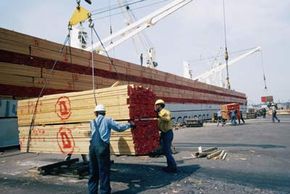Wood is a great building material. It is strong, lightweight, easily worked with tools and relatively inexpensive. The only problem with wood is that many varieties of bacteria, fungi and insects find it appetizing. When wood is in contact with the ground or moisture for any period of time, these organisms attack the wood. Untreated wood like pine will only last a year or two if it is touching moist ground.
Pressure-treated lumber is wood that has been immersed in a liquid preservative and placed in a pressure chamber. The chamber forces the chemical into the wood fibers. The pressurized approach makes sure that the chemical makes it to the core of each piece of wood -- it is much more effective than simply soaking the wood in the chemical.
Advertisement
The most common chemical used to treat lumber used to be chromated copper arsenate, or CCA. In 2003, however, the Environmental Protection Agency restricted the use of CCA in residential settings due to health and environmental concerns about arsenic leaching out of the wood. The most widely used alternative to CCA is alkaline copper quat, or ACQ. Copper is toxic to various insects and fungi that might cause decay. ACQ binds to wood fibers very well and allows wood to last decades even when it is in contact with the ground.
The protection provided by the chemical depends on the amount of chemical that the wood absorbs. In the United States, the amount of chemical is measured in pounds of chemical per cubic foot of wood. For ground contact, 0.40 pounds per cubic foot is needed. For foundations, 0.60 pounds per cubic foot is the standard.
The chemicals in treated wood are generally not good for humans. This is why you see warnings advising you to wear gloves, avoid breathing the sawdust, and refrain from burning treated wood. Keeping small children away from treated wood is also a good idea.
Advertisement
